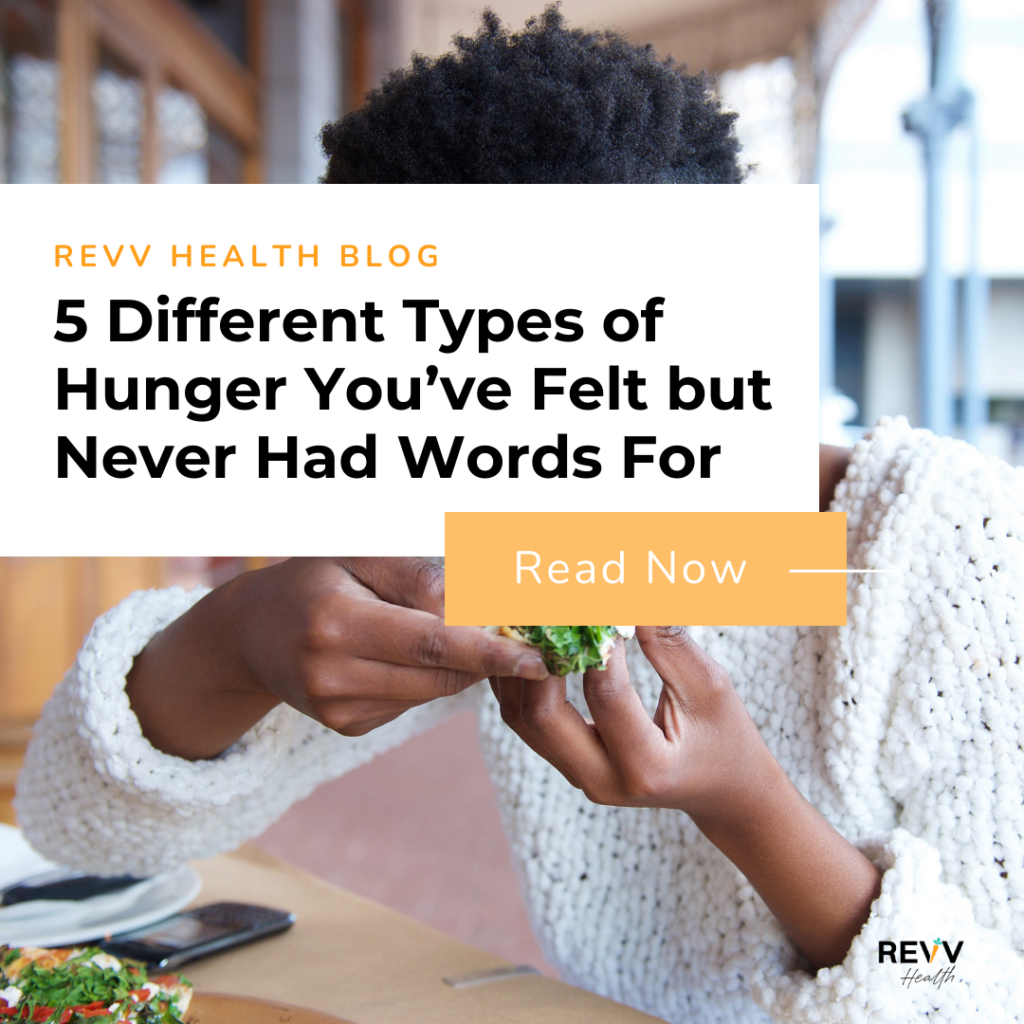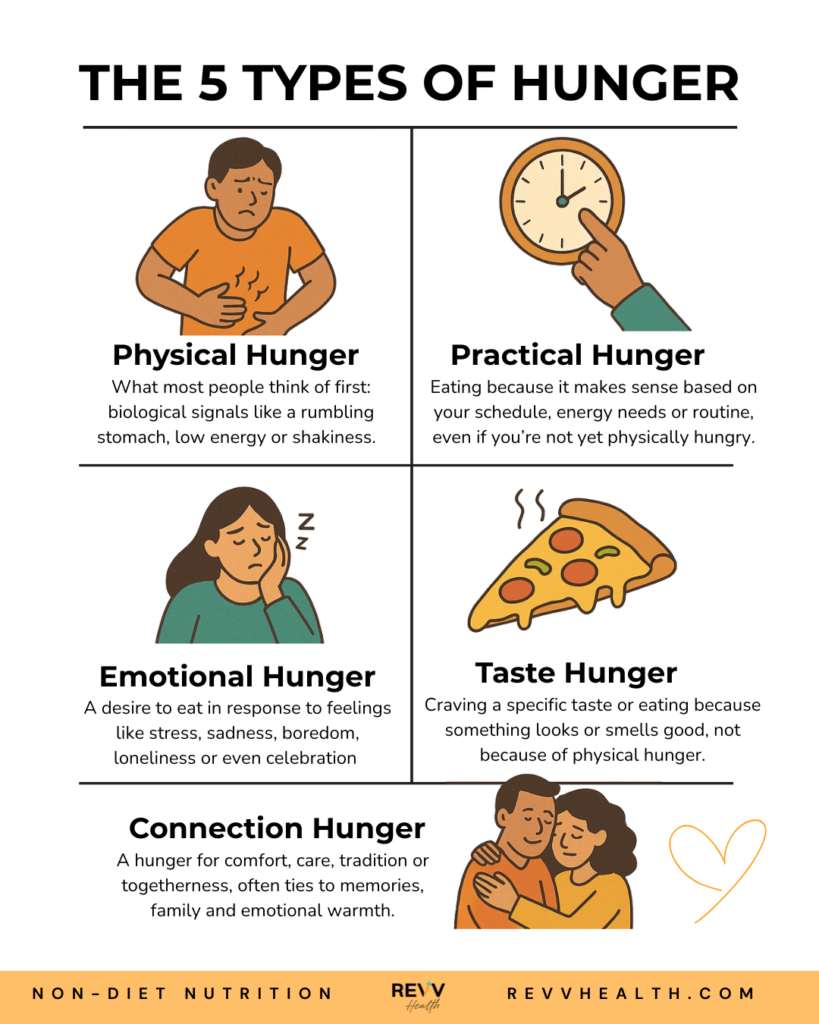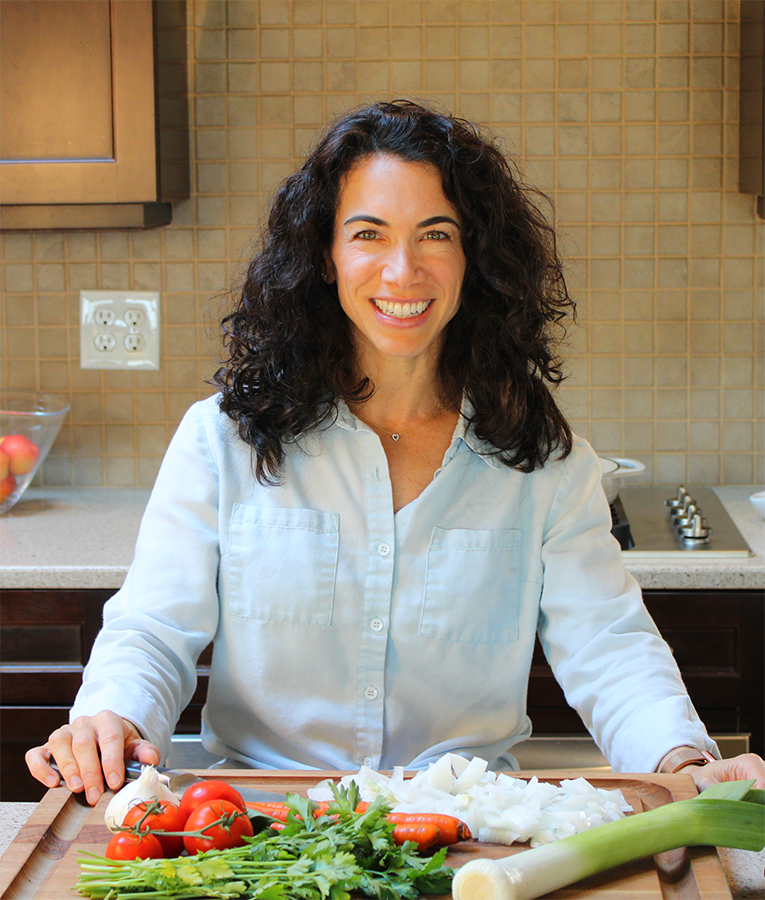If you’ve ever eaten when you weren’t technically hungry, or kept eating past fullness and wondered why, congratulations: you’re a fully formed human (not a robot!).
The idea that we should only eat when we feel physical hunger and stop the moment we’re full might sound ideal. But life doesn’t work that way.
We eat for all kinds of reasons: for energy, joy, culture, comfort, connection… and sometimes just because something looks really freaking good.
But if you’ve ever paused and thought,
“Wait, is it okay to eat right now?”
This blog will help you answer that, without second-guessing yourself.
If you’re new here, hi! I’m Marissa, a non-diet dietitian who absolutely loves food. I help people find peace with their eating and their bodies.
One of the first steps in healing that relationship is recognizing and validating all the ways hunger can show up. That’s what this post is about.
By the end, you’ll know the five types of hunger, why you eat the way you do, and (I hope) feel a little less hard on yourself when your eating doesn’t follow the “shoulds.”
Grab a fork, and let’s dive in!
What are the different types of hunger?
If you’ve ever thought, “Was I even hungry?” after eating something, I want you to know that’s completely normal.
And instead of being hard on yourself, what if you got curious?
Most of us were never taught to think about hunger, let alone that it could show up in more than one way. We’re told to wait for a growling stomach or that hangry, foggy feeling before we “allow” ourselves to eat.
But that’s only part of the story.
Hunger isn’t always loud. Sometimes it whispers.
It can show up as a craving, a need for comfort, a pull toward connection, or simply a response to life happening around you.
Here’s why this matters: when you don’t recognize these different types of hunger, it’s easy to assume you’re eating for the “wrong” reasons.
And that’s when guilt, overthinking, and those “I’ll be better tomorrow” promises kick in.
But once you understand what kind of hunger is actually showing up, you can:
- Stop second-guessing every food decision
- Respond to your needs thoughtfully, not reactively
- Ditch the guilt and work with your body and brain, not against them
Turns out, there are five different types of hunger, and they’re already shaping your eating, whether you realize it or not:
- Physical hunger: biological cues that your body needs energy (your tank is empty)
- Practical hunger: eating because it makes sense based on timing or routine (it’s 6 PM and your body knows dinner’s coming)
- Emotional hunger: eating in response to feelings (bad day? Cue the treat or glass of wine)
- Taste hunger: the desire to enjoy a specific food or flavor (nothing but a chocolate chip cookie will do)
- Connection hunger: eating to feel comforted, nostalgic, or close to others (lonely night = popcorn + Ben & Jerry’s)
Understanding these types of hunger shifts the question from:
“Should I be eating right now?”
to
“What am I really needing right now?”
So you can stop feeling guilty, stop second-guessing, and start responding to what your body and mind actually need.
Below, I will not only break them down but also offer how to honor each type of hunger in your everyday life.
Physical hunger
This is the type most people recognize, because it’s the only kind we’ve been told “counts.”
Physical hunger is your body’s way of saying, “Hey, I need fuel.”
But the thing is: it doesn’t always show up the way you expect.
It might feel like:
- A growling stomach
- Low energy or shakiness
- Lightheadedness or brain fog
- Irritability (“hangry” vibes)
- A dull headache
- A sense of hollowness or emptiness
For some people, physical hunger follows a predictable rhythm, such as every few hours after a meal. But for many (especially if you’ve dieted, dealt with stress, disordered eating, medical conditions, or certain meds like GLP-1s), those signals can get muted, delayed, or totally unreliable.
And that’s where a lot of frustration kicks in.
You start wondering:
- “Why don’t I feel hungry like I’m supposed to?”
- “How do I know when to eat if my body isn’t telling me?”
- “Am I doing this wrong?”
How to honor physical hunger
The first step: listen to your body.
Physical hunger often starts as a whisper… a subtle cue like low energy, a bit of brain fog, or a light sensation in your stomach.
Honoring it means noticing those early signs before you hit the point of feeling shaky, irritable, or ravenous.
But… what if you don’t feel hunger clearly?
If that’s you, it’s not a failure. It’s an adaptation. Your body has learned to cope in survival mode.
Regardless of how loud (or quiet) those cues are, you still deserve to eat.
This is where gentle structure becomes your ally, not as a rulebook, but as a way to rebuild trust. Planning regular meals and snacks, even when hunger feels fuzzy, gives your body the safety it needs to remember that food is reliable.
You’re not aiming for perfect hunger cues; you’re aiming to trust yourself to respond with care, consistency, and less second-guessing.
👉 And when cues aren’t clear (or life gets busy), this is exactly where practical hunger helps: choosing to eat before your body has to scream for it.
Practical hunger
Practical hunger is when you eat because it’s smart, not because your stomach told you to.
You might have a packed day, a workout coming up, or a toddler who’s about to wake up from a nap (making solo lunch impossible).
You eat now because waiting could mean missing the meal altogether.
This type of hunger gets dismissed by diet culture, but it’s completely valid. If you regularly wait until you’re ravenous, you’re also more likely to overeat (and then feel physically yucky and emotionally drained).
Practical hunger is meant to interrupt that cycle.
It’s especially relevant for caregivers, athletes, students, shift workers, or anyone trying to eat consistently with a less-than-predictable schedule.
Here’s what it looks like in real life:
- A nurse eats a solid breakfast before a 12-hour shift, even if appetite is low.
- A high school athlete grabs a sandwich after school before practice, knowing they’ll need the energy for a hard workout.
- A parent eats during nap time, not because of hunger, but because they know it’s now or never.
- A work-from-home program manager notices three back-to-back calls and grabs a balanced snack ahead of time.
This is how real people eat in real life.
How to honor this type of hunger:
If you’ve been conditioned to believe you should only eat when you feel hungry, honoring practical hunger can feel… wrong.
But you don’t need to “earn” your meals by waiting for hunger to get loud.
Choosing to eat proactively is a form of care.
Start noticing where predictable gaps happen in your day and give yourself full permission to fuel before you hit empty.
Whether that’s a snack before meetings, lunch before the hunger crash, or a pre-practice meal, responding early helps you avoid those extremes of starving ➝ overeating ➝ guilt.
You’re not avoiding hunger; you’re working with your body and your reality.
That’s smart. That’s self-trust in action.
👉 And just like planning for practical hunger keeps you steady, understanding emotional hunger helps you stay compassionate when food becomes a source of comfort, not just fuel.
Emotional hunger
Sometimes you reach for food not because you’re hungry, but because you’re feeling something: stressed, sad, anxious, bored, lonely… or even celebrating.
That’s emotional hunger.
- Maybe you crave something crunchy when you’re agitated.
- Something warm and carby when you’re overwhelmed.
- Or ice cream on a tough day because it’s familiar, soothing, and… honestly, why not?
Emotional eating gets a bad rap.
But eating in response to feelings isn’t wrong. It’s human.
The real issue isn’t that you turn to food for comfort; it’s when food becomes your only way to cope. And even then, the goal isn’t to be hard on yourself, but instead, figure out what’s driving it all.
Because once you understand emotional hunger, you can stop labeling yourself as “out of control” and start responding with care, whether that includes food, other forms of support, or both.
How to honor emotional hunger:
You’re allowed to find comfort in food. Let’s stop pretending that’s a problem.
Honoring emotional hunger means recognizing when food is the comfort you need, and when it’s a sign to check in a little deeper.
You don’t have to avoid emotional eating. But you can expand your options. Next time you notice emotional hunger showing up, try asking:
- What am I really needing right now?
- Will food help me feel supported, or am I hoping it’ll fix something it can’t?
- If I do choose to eat, can I stay present and be kind to myself while doing it?
Sometimes, food is the answer, and that’s okay.
Sometimes, a walk, a text to a friend, a deep breath, or turning off emails is what actually helps.
The goal isn’t to eliminate emotional eating. It’s to respond to your emotions – not react out of habit or guilt.
That’s how you honor emotional hunger: with awareness, kindness, and choice.
But not every reason to eat comes from emotions, a practical or physical need. Sometimes… you just want something because it tastes really freaking good.
👉 And while diet culture loves to shame eating just for pleasure, taste hunger is completely valid. Satisfaction deserves a seat at the table.
Taste hunger
Sometimes… you just want the thing.
Not because you’re hungry.
Not because you’re emotional.
Just because it looks, smells, or sounds really good.
That’s taste hunger: the desire to eat for pleasure. It’s the cookie fresh out of the oven. The cheese board at a party. A bite while preparing dinner.
Or saying yes to dessert, even when you’re physically full.
But here’s the problem:
Diet culture tells us that pleasure has to be earned. That you don’t “deserve” certain foods unless your body has a biological need for them.
I’m calling BS.
Enjoying food is normal. Craving flavor is normal. And honoring taste hunger is part of having a calm, trusting relationship with food.
When you consistently allow satisfaction, you are less likely to feel out of control later. Because it’s not indulgence, it’s balance.
How to honor taste hunger:
Honoring taste hunger means giving yourself permission to enjoy food on purpose (without waiting for hunger, without guilt, and without turning it into an unconscious habit).
It’s staying present enough to actually enjoy what you’re eating.
Here’s how:
- If something looks or sounds good, pause and say yes intentionally.
- Serve yourself enough to feel satisfied, not sneaky.
- Actually taste it. No distractions or rushing.
- And when you’re done, move on. No need for guilt.
The more you allow pleasure in your eating, the less power food holds over you.
Taste hunger isn’t something to avoid; it’s something to respect.
Because satisfaction is just as important as nutrition when it comes to feeling grounded around food.
👉 And sometimes, what satisfies you isn’t just the flavor on your plate; it’s the people you share it with, the memories it brings back, or the comfort of feeling connected.
That’s where connection hunger comes in.
Connection hunger
And finally, the most underrated type of all: connection hunger.
This is the hunger that shows up when food is about more than just food.
- It’s when you eat to feel close to someone.
- When you cook a dish that reminds you of home.
- When you say yes to birthday cake even though you’re full – because being part of the moment matters.
Connection hunger is woven into memory, culture, ritual, grief, celebration, and love.
Think about it:
- Do you remember what you ate on your first date?
- Your favorite holiday meal?
- The comfort food someone made for you when life felt heavy?
If we only focus on food as “fuel,” we miss out on… life.
You don’t need to be physically hungry to eat for connection. You just need to be present enough to recognize it, honor it, and allow it to happen without guilt.
Because sharing food is part of being human.
How to honor connection hunger:
Honoring connection hunger means saying yes to moments that matter without second-guessing whether you’re “allowed” to eat.
It’s understanding that sometimes, eating is about belonging, tradition, comfort, or simply being part of something bigger than yourself.
Here’s how:
- Join in the meal, even if you’re not hungry. Because connection feeds more than your stomach.
- Notice when a dish holds meaning. And let yourself enjoy it fully.
- Let go of food rules in social settings. Being present is more important than sticking to a plan.
- Declining food to “be good” doesn’t make memories. Sharing does.
Connection hunger reminds us that food isn’t just about nutrients. Food is how we connect with others, build relationships, honor our culture, and offer care.
Food connects us, and that’s always worth saying yes to.
How to use the 5 different types of hungers without overthinking food
Now that you know the five types of hunger, you might be wondering…
“Okay, but how do I actually use this without turning every meal or snack into a deep analysis?”
The good news is you don’t need to label every bite or obsess over getting it right.
The point of understanding these types of hunger isn’t to create a new set of rules. It’s to give you clarity when those old thoughts creep in:
- “Why am I eating right now?”
- “Is this bad?”
- “Should I be hungry?”
Instead of spiraling, you’ll now have language and options.
Here’s how to keep it simple:
- Pause (briefly): If you notice yourself questioning, just ask, “Which kind of hunger might this be?”
- Decide with kindness: Whether it’s physical, practical, emotional, taste, connection (or you’re not sure), it’s okay to eat. Make the choice on purpose, not out of panic.
- Move on without guilt. No mental math. Just trust that responding to your needs isn’t something you have to earn or justify.
I want to reiterate: this isn’t about perfect awareness. What you’re really trying to do is build enough understanding to stop second-guessing yourself, respond to your needs with care, and let food feel a little less complicated.
Reading to make food feel less complicated?
If you’ve made it this far, here’s what I hope you’re walking away with:
- Recognizing the 5 types of hunger helps you stop second-guessing and start trusting yourself around food.
- There is a way that you can honor each of them when they come up for you.
- More importantly, you now know how to respond to your body (and mind) with care vs. self-criticism.
If you’re still feeling unsure how to apply the different types of hunger in real life while trying to manage a condition and reach your health goals, this is what I help people learn how to do.
I offer free 20-minute calls (nationwide), where we’ll talk through how you’re getting caught up, why food feels harder than it should, and what small, sustainable shifts can help you feel more at ease with eating and your body.
This is a no-pressure, no-obligation call. Just a real conversation where I’ll offer expert guidance to help you figure out what’s next, whether that’s working together or simply having more clarity moving forward.
👉 Book your free call here – and let’s take the first step toward making food feel easier, calmer, and more aligned with the life you actually want to live.




0 Comments